The UCL-Tohoku University joint Symposium is coming soon!
Posted by Tohru Yano, on 18 February 2013
Posted by Tohru Yano, on 18 February 2013
Posted by Erin M Campbell, on 15 February 2013
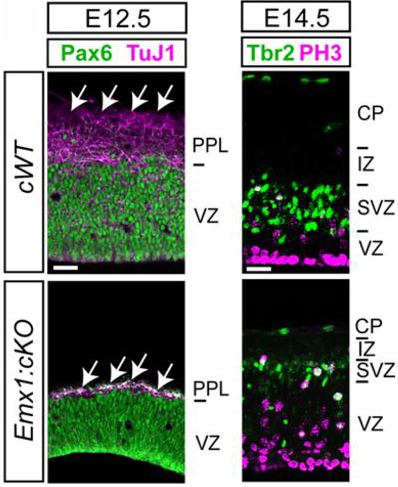 A lot of things cycle in life, even down to the cellular level. In the developing central nervous system, regulators of the cell cycle play important roles in maintaining the balance between stem cell self-renewal and differentiation. A recent paper in the journal Development describes a cell cycle regulator in stem and progenitor cells in the nervous system.
A lot of things cycle in life, even down to the cellular level. In the developing central nervous system, regulators of the cell cycle play important roles in maintaining the balance between stem cell self-renewal and differentiation. A recent paper in the journal Development describes a cell cycle regulator in stem and progenitor cells in the nervous system.
The developing central nervous system depends on the divisions of neural stem cells (NSCs) and intermediate neural progenitor cells (NPCs). In early development, NSCs continuously self-renew in the ventricular zones of the early neuroectoderm. After neuroectoderm specification, NSCs give rise to NPCs, which divide and differentiate into many different types of neurons. Proteins that regulate the progression through different phases of the cell cycle have been shown to regulate NSC and NPC divisions, specifically affecting the balance between proliferative and neurogenic cell divisions. A recent paper in the journal Development identified the role of a zinc-finger transcription factor specificity protein 2 (Sp2) in regulating cell cycle progression in NSCs and NPCs. Liang and colleagues found Sp2 expression in NSCs and NPCs in the embryonic and postnatal CNS. Conditional Sp2-null mice had mitosis-arrested NSCs and NPCs in vivo. In addition, conditional deletion of Sp2 caused a decrease in the number of NPCs and neurons in developing and postnatal brains, as seen in the images above. Compared with normal cerebral cortex tissue in the early mouse embryo (E12.5), Sp2-deleted tissue (bottom) had a reduced number of postmitotic neurons (purple, arrows, left column). NSCs (green, left column) occupied the entire thickness of the Sp2-null cerebral cortex, whereas NSCs occupy only the ventricular zone (VZ) in control tissue. In addition, NPCs (green, right column) were less dense in Sp2-null tissue a bit later in development (E14.5), compared with control cerebral cortex.
For a more general description of this image, see my imaging blog within EuroStemCell, the European stem cell portal.
Liang, H., Xiao, G., Yin, H., Hippenmeyer, S., Horowitz, J., & Ghashghaei, H. (2013). Neural development is dependent on the function of specificity protein 2 in cell cycle progression Development, 140 (3), 552-561 DOI: 10.1242/dev.085621
Posted by Stephen Frankenberg, on 12 February 2013
Marsupials were popular models for early development in the early 1900s , with classic morphological studies performed by notable embryologists such as J.P. Hill, C.G. Hartman, T.T. Flynn (Errol Flynn’s father) and E. McCrady. These workers were fascinated by the marsupial mode of blastocyst formation, which contrasts starkly with that of eutherians. One key difference is that marsupial zygotes contain large amounts of deutoplasm (often called yolk, but probably with a minimal nutritive role), which is expelled into the extracellular space during cleavage. Consequently, the marsupial conceptus never forms a morula and early blastomeres instead adhere to the inner surface of the zona pellucida where they form a single-cell-layered (unilaminar) epithelium. The resulting blastocyst thus lacks an inner cell mass and the embryonic disc develops much later from cells within a restricted region of the epithelium. Marsupial early development thus retains features that are reminiscent of their much yolkier ancestors but on a smaller scale. They can help us to understand how eutherian early development evolved by elucidating homologies in morphological mechanisms and cell lineages among vertebrates.
Now that three marsupial genomes (wallaby, opossum and Tasmanian devil) have been sequenced, new doors are opening for exploring these homologies. In our first detailed molecular analysis of marsupial early cell lineage specification, one of the more interesting findings is that key regulatory factors known from mouse development appear to be uniformly expressed and localised in all cells of the early unilaminar blastocyst, although underlying biases in cell fate could still exist. This raises the possibly that totipotent stem cells could be derived for the first time in any mammal. We plan to explore this and other avenues and hope that our study is just the beginning of a renaissance in marsupial early embryology!

Posted by Seema Grewal, on 12 February 2013
Here are the research highlights from the current issue of Development:
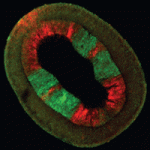 Fibroblast growth factors (FGFs) are essential for mesoderm induction in vertebrates and for early mesoderm formation in invertebrate chordates. However, functional studies to date do not support a role for FGF signalling in mesoderm induction in other deuterostomes (animals in which the first embryonic opening forms the anus), such as sea urchins. Thus, the ancestral role of FGF signalling during mesoderm specification in deuterostomes is unclear. On p. 1024, Christopher Lowe and co-workers examine the role of FGF signalling during the early development of the hemichordate Saccoglossus kowalevskii. The researchers report that the FGF ligand fgf8/17/18 is expressed in the ectoderm overlying sites of mesoderm specification within this marine worm’s archenteron (primitive gut) endomesoderm. Mesoderm induction, they show, requires contact between the ectoderm and the endomesoderm. Moreover, loss-of-function experiments indicate that FGF ligand and receptor are both necessary for mesoderm specification. These and other results indicate that FGF signalling is required throughout mesoderm specification in hemichordates and support an ancestral role for FGF signalling in mesoderm formation in deuterostomes.
Fibroblast growth factors (FGFs) are essential for mesoderm induction in vertebrates and for early mesoderm formation in invertebrate chordates. However, functional studies to date do not support a role for FGF signalling in mesoderm induction in other deuterostomes (animals in which the first embryonic opening forms the anus), such as sea urchins. Thus, the ancestral role of FGF signalling during mesoderm specification in deuterostomes is unclear. On p. 1024, Christopher Lowe and co-workers examine the role of FGF signalling during the early development of the hemichordate Saccoglossus kowalevskii. The researchers report that the FGF ligand fgf8/17/18 is expressed in the ectoderm overlying sites of mesoderm specification within this marine worm’s archenteron (primitive gut) endomesoderm. Mesoderm induction, they show, requires contact between the ectoderm and the endomesoderm. Moreover, loss-of-function experiments indicate that FGF ligand and receptor are both necessary for mesoderm specification. These and other results indicate that FGF signalling is required throughout mesoderm specification in hemichordates and support an ancestral role for FGF signalling in mesoderm formation in deuterostomes.
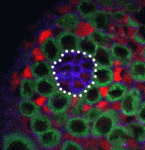 In adult stem cell niches, crosstalk between extrinsic cues (such as signals from neighbouring cells) and intrinsic cues (such as chromatin structure) regulates stem cell identity and activity. Now, on p. 1014, Xin Chen and colleagues report that the histone demethylase dUTX regulates crosstalk among the germline stem cells (GSCs), hub cells and cyst stem cells (CySCs) of the Drosophila testis niche. The researchers show that dUTX acts in CySCs to maintain hub cell identity by activating transcription of the Socs36E gene (which encodes an inhibitor of the JAK-STAT signalling pathway that is required for GSC identity and activity) via removal of a repressive histone modification near its transcription start site. dUTX also acts in GSCs, they report, to maintain hub structure through regulation of DE-cadherin, the Drosophila homologue of vertebrate cadherins. These results show how an epigenetic factor regulates crosstalk among different cell types within an adult stem cell niche and provide important information about the in vivo function of a histone demethylase.
In adult stem cell niches, crosstalk between extrinsic cues (such as signals from neighbouring cells) and intrinsic cues (such as chromatin structure) regulates stem cell identity and activity. Now, on p. 1014, Xin Chen and colleagues report that the histone demethylase dUTX regulates crosstalk among the germline stem cells (GSCs), hub cells and cyst stem cells (CySCs) of the Drosophila testis niche. The researchers show that dUTX acts in CySCs to maintain hub cell identity by activating transcription of the Socs36E gene (which encodes an inhibitor of the JAK-STAT signalling pathway that is required for GSC identity and activity) via removal of a repressive histone modification near its transcription start site. dUTX also acts in GSCs, they report, to maintain hub structure through regulation of DE-cadherin, the Drosophila homologue of vertebrate cadherins. These results show how an epigenetic factor regulates crosstalk among different cell types within an adult stem cell niche and provide important information about the in vivo function of a histone demethylase.
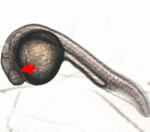 Members of the Eaf gene family are involved in tumour suppression and in embryogenesis but what are the molecular mechanisms that underlie these activities? Here (p. 1067), Wuhan Xiao and colleagues report that eaf1 and eaf2 modulate mesodermal and neural patterning in zebrafish embryos through inhibition of canonical Wnt/β-catenin signalling. They show that ectopic expression of eaf1 and eaf2 in zebrafish embryos and in cultured cells blocks β-catenin reporter activity. Furthermore, they show that Eaf1 and Eaf2 bind to the Armadillo repeat region and C-terminus of β-catenin, and to other β-catenin transcription complex proteins. Both the N- and C-terminus of Eaf1 and Eaf2 must be intact for their suppressive activity, they report. Finally, they show that the biological activities of Eaf family proteins are conserved across species. Together, these results identify a novel role for Eaf1 and Eaf2 in the inhibition of canonical Wnt/β-catenin signalling that might provide the mechanistic basis for the tumour suppressor activity of Eaf family proteins.
Members of the Eaf gene family are involved in tumour suppression and in embryogenesis but what are the molecular mechanisms that underlie these activities? Here (p. 1067), Wuhan Xiao and colleagues report that eaf1 and eaf2 modulate mesodermal and neural patterning in zebrafish embryos through inhibition of canonical Wnt/β-catenin signalling. They show that ectopic expression of eaf1 and eaf2 in zebrafish embryos and in cultured cells blocks β-catenin reporter activity. Furthermore, they show that Eaf1 and Eaf2 bind to the Armadillo repeat region and C-terminus of β-catenin, and to other β-catenin transcription complex proteins. Both the N- and C-terminus of Eaf1 and Eaf2 must be intact for their suppressive activity, they report. Finally, they show that the biological activities of Eaf family proteins are conserved across species. Together, these results identify a novel role for Eaf1 and Eaf2 in the inhibition of canonical Wnt/β-catenin signalling that might provide the mechanistic basis for the tumour suppressor activity of Eaf family proteins.
 During morphogenesis, the elongation of polarised tissues involves cells within epithelial sheets and tubes making and breaking intercellular contacts in an oriented manner. How cells remodel their junctional contacts is poorly understood but growing evidence suggests that localised endocytic trafficking of E-cadherin might modulate cell adhesion. Now, Samantha Warrington and co-workers (p. 1045) report that the Frizzled-dependent core planar polarity pathway, which has been implicated in the regulation of cell adhesion through E-cadherin trafficking, promotes polarised cell rearrangements in Drosophila. The researchers report that the core planar polarity pathway promotes cell intercalation during tracheal tube morphogenesis by promoting E-cadherin turnover at junctions through local recruitment and regulation of the guanine exchange factor RhoGEF2. Core planar polarity pathway activity also leads to planar-polarised recruitment of RhoGEF2 and E-cadherin in the epidermis of the embryonic germband and the pupal wing. Thus, the researchers suggest, local promotion of E-cadherin endocytosis through recruitment of RhoGEF2 is a general mechanism by which the core planar polarity pathway promotes polarised cell rearrangements.
During morphogenesis, the elongation of polarised tissues involves cells within epithelial sheets and tubes making and breaking intercellular contacts in an oriented manner. How cells remodel their junctional contacts is poorly understood but growing evidence suggests that localised endocytic trafficking of E-cadherin might modulate cell adhesion. Now, Samantha Warrington and co-workers (p. 1045) report that the Frizzled-dependent core planar polarity pathway, which has been implicated in the regulation of cell adhesion through E-cadherin trafficking, promotes polarised cell rearrangements in Drosophila. The researchers report that the core planar polarity pathway promotes cell intercalation during tracheal tube morphogenesis by promoting E-cadherin turnover at junctions through local recruitment and regulation of the guanine exchange factor RhoGEF2. Core planar polarity pathway activity also leads to planar-polarised recruitment of RhoGEF2 and E-cadherin in the epidermis of the embryonic germband and the pupal wing. Thus, the researchers suggest, local promotion of E-cadherin endocytosis through recruitment of RhoGEF2 is a general mechanism by which the core planar polarity pathway promotes polarised cell rearrangements.
Adult stem cells are crucial for the growth, homeostasis and regeneration of adult tissues. Melanocyte (melanophore) stem cells (MSCs), which give rise to pigment cells in vertebrates, are an attractive model for studying the regulation of adult stem cells. In this issue, two papers provide new information about the involvement of signalling by the receptor tyrosine kinases Kit and ErbB in the establishment of MSCs in zebrafish.
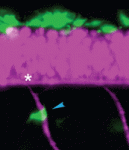 On p. 1003, Christiane Nüsslein-Volhard and colleagues investigate the embryonic origin of the melanophores that emerge during juvenile development and that contribute to the striking colour patterns of adult zebrafish. The researchers identify a small set of melanophore progenitors (MPs) that are established early in embryonic development and that are associated with the segmentally reiterated dorsal root ganglia in the fish. They use lineage analysis and four-dimensional in vivo imaging to show that the progeny of these embryonic MPs spread segmentally and give rise to the melanophores that create the adult melanophore stripes. Other experiments indicate that the MPs require zebrafish kit ligand a (kitlga, also known as slk) to function as MSCs, and that MP establishment depends on ErbB signalling during early embryonic development. Based on their results, the researchers propose that dorsal root ganglia provide a niche for MSCs and suggest that Kit signalling might attract and maintain MSCs in this niche.
On p. 1003, Christiane Nüsslein-Volhard and colleagues investigate the embryonic origin of the melanophores that emerge during juvenile development and that contribute to the striking colour patterns of adult zebrafish. The researchers identify a small set of melanophore progenitors (MPs) that are established early in embryonic development and that are associated with the segmentally reiterated dorsal root ganglia in the fish. They use lineage analysis and four-dimensional in vivo imaging to show that the progeny of these embryonic MPs spread segmentally and give rise to the melanophores that create the adult melanophore stripes. Other experiments indicate that the MPs require zebrafish kit ligand a (kitlga, also known as slk) to function as MSCs, and that MP establishment depends on ErbB signalling during early embryonic development. Based on their results, the researchers propose that dorsal root ganglia provide a niche for MSCs and suggest that Kit signalling might attract and maintain MSCs in this niche.
![]() On p. 996, Thomas O’Reilly-Pol and Stephen Johnson use clonal analysis to investigate which stages of melanocyte regeneration – establishment of MSCs, recruitment of MSCs to produce committed daughter cells, or the proliferation, differentiation and survival of these daughter cells – are affected by Kit signalling deficits; previous work had shown that a reduction in Kit signalling results in dose-dependent reductions of melanocytes during larval regeneration. The researchers show that the reduction in melanocytes in kita mutants is due to a defect in MSC establishment. By contrast, the other stages of melanocyte regeneration are unaffected. Additional analyses indicate that the MSC establishment defect in kita mutants arises from inappropriate differentiation of the MSC lineage, a finding that confirms and extends the results presented by Nüsslein-Volhard and colleagues.
On p. 996, Thomas O’Reilly-Pol and Stephen Johnson use clonal analysis to investigate which stages of melanocyte regeneration – establishment of MSCs, recruitment of MSCs to produce committed daughter cells, or the proliferation, differentiation and survival of these daughter cells – are affected by Kit signalling deficits; previous work had shown that a reduction in Kit signalling results in dose-dependent reductions of melanocytes during larval regeneration. The researchers show that the reduction in melanocytes in kita mutants is due to a defect in MSC establishment. By contrast, the other stages of melanocyte regeneration are unaffected. Additional analyses indicate that the MSC establishment defect in kita mutants arises from inappropriate differentiation of the MSC lineage, a finding that confirms and extends the results presented by Nüsslein-Volhard and colleagues.
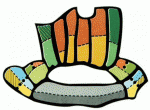 In 1993, Liam Dolan, Ben Scheres and colleagues published a paper in Development detailing the anatomical structure of the Arabidopsis root. As part of the Development Classics series, Ben Scheres discusses how this work underpinned subsequent research on root developmental biology and sparked a detailed molecular analysis of how stem cell groups are positioned and maintained in plants. See the Spotlight article on p. 939
In 1993, Liam Dolan, Ben Scheres and colleagues published a paper in Development detailing the anatomical structure of the Arabidopsis root. As part of the Development Classics series, Ben Scheres discusses how this work underpinned subsequent research on root developmental biology and sparked a detailed molecular analysis of how stem cell groups are positioned and maintained in plants. See the Spotlight article on p. 939
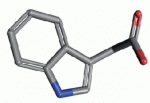 Auxin plays important roles during the entire life span of a plant. Auxin metabolism is not well understood but recent discoveries, reviewed by Karin Ljung, have started to shed light on the processes that regulate the synthesis and degradation of this important plant hormone. See the Primer article on p. 943
Auxin plays important roles during the entire life span of a plant. Auxin metabolism is not well understood but recent discoveries, reviewed by Karin Ljung, have started to shed light on the processes that regulate the synthesis and degradation of this important plant hormone. See the Primer article on p. 943
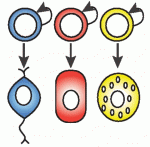 Regeneration in planarians requires a population of cells known as neoblasts. Recent data, discussed by Peter Reddien, indicate that some neoblasts express lineage-specific factors during regeneration and in uninjured animals, suggesting that an important early step in planarian regeneration is neoblast specialization. See the Hypothesis article on p. 951
Regeneration in planarians requires a population of cells known as neoblasts. Recent data, discussed by Peter Reddien, indicate that some neoblasts express lineage-specific factors during regeneration and in uninjured animals, suggesting that an important early step in planarian regeneration is neoblast specialization. See the Hypothesis article on p. 951
Posted by Eva Amsen, on 7 February 2013
Last year, Matter launched, after a successful Kickstarter campaign, as a magazine that publishes only long, well-written articles related to “science, technology and the ideas shaping our future”. Each issue is one article, which costs $0.99 to access. (On my iPad, they ‘re categorized as books, and are each about 40 pages long, which I think justifies both the price and the fact that I’m filing this under “book review”.)
The latest issue is of Matter is about online scammers, but the one before that was about developmental biology! Or rather, “Electric Shock”, written by Cynthia Graber, is about a biologist. It profiles the life of Michael Levin and his work in understanding the role of bioelectricity in organ regeneration.
Matter’s audience is broad, and most of them are not biologists, so when Graber describes Levin’s work, she also has to explain the basics of developmental biology: “One cell divides into two, two into four, four into eight, continuing until there are dozens, thousands, millions of them. In the process, some cells transform into blood, others into bone; some into tissue, others into tendon.”
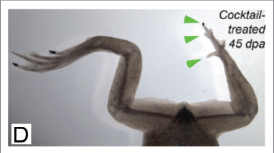 The specific work described in the article is a study published in Communicative and Integrative Biology last month, as an addendum to an earlier paper from the Levin lab in The Journal of Neuroscience. Their earlier work had shown that tadpole tails can regenerate in response to regulated ion transport, and that bioelectric signals can induce ectopic eyes in tadpoles, but now they also achieved regeneration in (older) developing frogs’ legs!
The specific work described in the article is a study published in Communicative and Integrative Biology last month, as an addendum to an earlier paper from the Levin lab in The Journal of Neuroscience. Their earlier work had shown that tadpole tails can regenerate in response to regulated ion transport, and that bioelectric signals can induce ectopic eyes in tadpoles, but now they also achieved regeneration in (older) developing frogs’ legs!
In “Electric Shock”, Graber describes not just the work itself, but the context. Why did Levin become interested in bioelectricity? What was he like as a child? How does he spend his time outside of the lab? We learn that Levin takes his parents to Florida each year, for a few weeks in March. He brings along a lot of reading material on those trips, to think about his work from new angles, and discusses it with his family. “…at night, he explains his thoughts to his father over dinner. “If I can’t explain my ideas to a very smart non-expert then I haven’t really fleshed them out properly anyway,” he says.””
I love reading profiles of researchers that go beyond what’s in the scientific literature. In this case, I was especially amused because the very week that this issue of Matter came out, we also published one of Levin’s papers in Development, so he was suddenly everywhere! His most recent Development paper was about planarian regeneration, which wasn’t covered in the Matter piece, but we also published the frog ectopic eye work last year, and it was great to get a glimpse into the lab where the work was done.
Read the original article:
Electric Shock – by Cynthia Graber
Papers mentioned in this review:
Tseng A. & Levin M. (2013). Cracking the bioelectric code: Probing endogenous ionic controls of pattern formation, Communicative & Integrative Biology, 6 (1) e22595. DOI: 10.4161/cib.22595
Tseng A.S., Beane W.S., Lemire J.M., Masi A. & Levin M. (2010). Induction of Vertebrate Regeneration by a Transient Sodium Current, Journal of Neuroscience, 30 (39) 13192-13200. DOI: 10.1523/JNEUROSCI.3315-10.2010
Beane W.S., Morokuma J., Lemire J.M. & Levin M. (2013). Bioelectric signaling regulates head and organ size during planarian regeneration, Development, 140 (2) 313-322. DOI: 10.1242/dev.086900
Pai V.P., Aw S., Shomrat T., Lemire J.M. & Levin M. (2012). Transmembrane voltage potential controls embryonic eye patterning in Xenopus laevis, Development, 139 (2) 313-323. DOI: 10.1242/dev.073759
(Disclaimer: I contributed to the Matter Kickstarter campaign and as a result I am on their massive editorial board and get to be part of crowdsourced topic suggestions for the magazine. However, I was not involved in commissioning this piece, and was as pleasantly surprised as anyone to suddenly find a profile of a developmental biologist in a broader media publication!)
Posted by Eva Amsen, on 1 February 2013
 The annual Science Online conference is currently underway in North Carolina. It attracts mainly scientists and science writers who use the internet to advance science communication. Everyone at the conference is extremely Twitter-savvy, and it’s impossible to keep up with the #scio13 hashtag, but I’ve created a Storify below that includes some of the tweets from some of the sessions that you might be interested in. From the first day I included sessions about first person narrative in talking about your research, about using visual metaphors, about outreach, about electronic notebooks, and about peer review. The Storify will be updated over the weekend to include more sessions as they happen.
The annual Science Online conference is currently underway in North Carolina. It attracts mainly scientists and science writers who use the internet to advance science communication. Everyone at the conference is extremely Twitter-savvy, and it’s impossible to keep up with the #scio13 hashtag, but I’ve created a Storify below that includes some of the tweets from some of the sessions that you might be interested in. From the first day I included sessions about first person narrative in talking about your research, about using visual metaphors, about outreach, about electronic notebooks, and about peer review. The Storify will be updated over the weekend to include more sessions as they happen.
If you’re not at the conference, you might still be able to join one of the affiliated Watch Parties that are taking place across the world to allow others to view some of the sessions. I’m co-hosting the London Watch Party tomorrow. (Feel free to join if you’re nearby!)
Storify:
(more…)
Posted by Jessica Whited, on 1 February 2013
Many salamanders can regenerate limbs, and even a seven-year-old child appreciates exactly the reasons why this feat is so remarkable. How can an animal that has been living its life, using its leg full of muscles and bones and tendons and nerves every single day, suddenly grow a new one at some random time? When the leg first grew on the same salamander when it was just a tiny animal, we can imagine it followed a prescribed developmental program for its instructions and used a prescribed pool of progenitor cells for its construction. Once the limb tissues are already working, the cells are differentiated and doing their jobs, so how do they go back in time and create tissues anew? Scientific understanding of how limbs develop has progressed immensely over the last several decades, but understanding of how limbs can regenerate and why some animals do it better than others has remained elusive. This lag in understanding vertebrate limb regeneration on a molecular level stems from the fact that the two model systems with the most sophisticated tools for studying limb development—chick and mouse—do not naturally regenerate entire limbs as adults. Figuring out what the regenerative roadblocks are in chick, mouse, and human will be imperative for improving regeneration in species that do not do it well. However, it will be equally important—and perhaps fundamental for elucidating these roadblocks—to understand how animals that regenerate limbs remarkably well do it. This is why we are developing tools that allow for more precise molecular genetic and cell biological inquiry into axolotl limb regeneration.
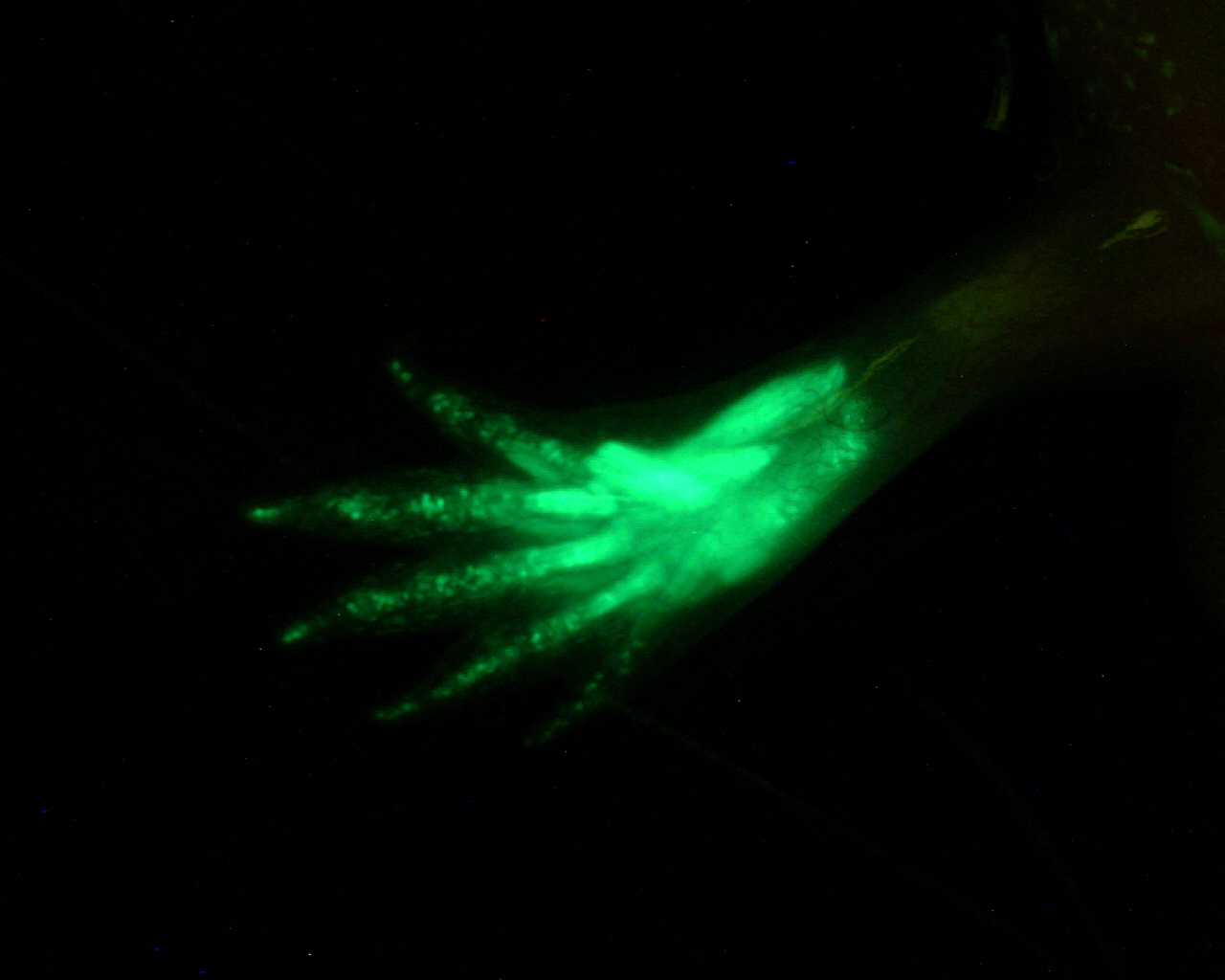
EGFP expression in a live animal. This axolotl hindlimb was amputated mid-femur. The blastema that formed was infected with EGFP-encoding retrovirus two weeks post-amputation, and the limb was allowed to fully regenerate. Cells descended from infected blastema cells express EGFP. Since the injection was limited to the blastema, cells proximal to the amputation plane do not express EGFP.
Two things a researcher might want to do when studying how salamanders regenerate limbs are tracking cells during regeneration and expressing introduced genetic elements to analyze their effects. In the past, labeling methods such as heavy isotopes, dyes, and electroporation of plasmid DNA have been used in regenerating salamander limbs. Electroporation of plasmid DNA has also been used to mis-express genetic elements. While studies using these methods provided key insights into, for example, which cells become mitotically active following amputation, all three of these methods suffer a similar drawback: the element gets diluted with each successive cell division, and in a regenerating limb, lots of cell division occurs. It was impossible to follow cells from the stump, through the blastema (group of relatively dedifferentiated cells that forms at the tip of the stump and will give rise to internal limb tissues in the regenerate), and into the new limb. Transplantation studies using tissues from permanently marked donors, such as animals induced to have a different ploidy or transgenic animals, have aimed to bypass these caveats, but transplantation is not ideal in many situations (for example, some tissues cannot be cleanly separated, and the procedure itself is obviously invasive and best done well before limb regeneration will be studied). Furthermore, donor tissue is relatively limited at this point to just a few genetic lines of axolotls constitutively expressing a fluorophore, and generation of novel animals by transgenesis is a lengthy and labor-intensive process. Expression studies using electroporated plasmid DNA were limited because even good electroporations may not lead to enough sustained expression to detect an effect. In our Development paper, we showed that retroviruses can infect regenerating axolotl limbs. These retroviruses are simply injected into limb tissue, and they can infect any mitotically active cell they encounter. Since the retroviral genomes integrate into host cells, they can be used to permanently express a label such as GFP, which allows for tracking cells during regeneration, opening the door to many future studies. Expression from the retroviral vectors is robust and using retroviruses might be a powerful way to finally address the consequences of misexpressing candidate genes during limb regeneration. Additionally, we showed that retroviral infections can in principle be targeted to specific cell types by targeting infections to vascular endothelial cells. This works by borrowing technology exploited by other researchers in the mouse. Axolotl and mouse cells do not make the receptor for a particular coat protein found on the surface of certain bird viruses. However, if axolotls or mice are made to express that receptor, they can become infected by viruses with these coats, and expression of the receptor can be confined to particular cell types by the researcher provided genetic elements for doing so (for example, a cell-type-specific promoter) exist. Hence, the retroviruses can also someday be targeted to a whole battery of different specific cell types in regenerating axolotl limbs once cell-type-specific promoters are found. These tools will allow for more precise control of labels and introduced gene expression during regeneration.
Figuring out how salamanders regenerate limbs won’t just satisfy the curiosity of the seven-year-old in us all, it also stands to someday dramatically improve the lives of the millions of people living with the consequences of limb amputation. With key risk factors such as diabetes and peripheral artery disease on the rise, limb loss is unfortunately becoming an even more common problem in places like the United States, giving scientists a call to arms when it comes to unraveling the mystery of limb regeneration.
Posted by the Node, on 31 January 2013
Let’s start this monthly summary with two fantastic posts that were left out of last month’s roundup due to the holiday period (and scheduled posts).
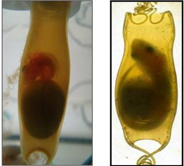 Idoia Quintana studies shark brain development in Spain, and travelled to Scotland recently to learn how to work with mouse brains, so she could do some cross-species comparison.
Idoia Quintana studies shark brain development in Spain, and travelled to Scotland recently to learn how to work with mouse brains, so she could do some cross-species comparison.
“At the beginning was tricky, working with mice was a big challenge for me; but at the same time was amazing to do research in a species in which several optimized techniques are available. Particularly I enjoyed learning slice culture techniques and I hope to have time to implement them in shark embryos and perform some axon guidance experiments upon my return.”
Benjamin Coyac attended the UPMC/Curie Institute International Course in Developmental Biology, and described what it was like to study in Paris for several weeks with students from around the world.
“The intensity of the program enabled us to get to know each other very quickly. Little talks about science or our lives as international students began to build a common experience in our shared interest in developmental biology. By the end of the program, not only we had acquired scientific skills in theory, methods and practicals, but also we became friends and started to build a strong network of future developmental scientists.”
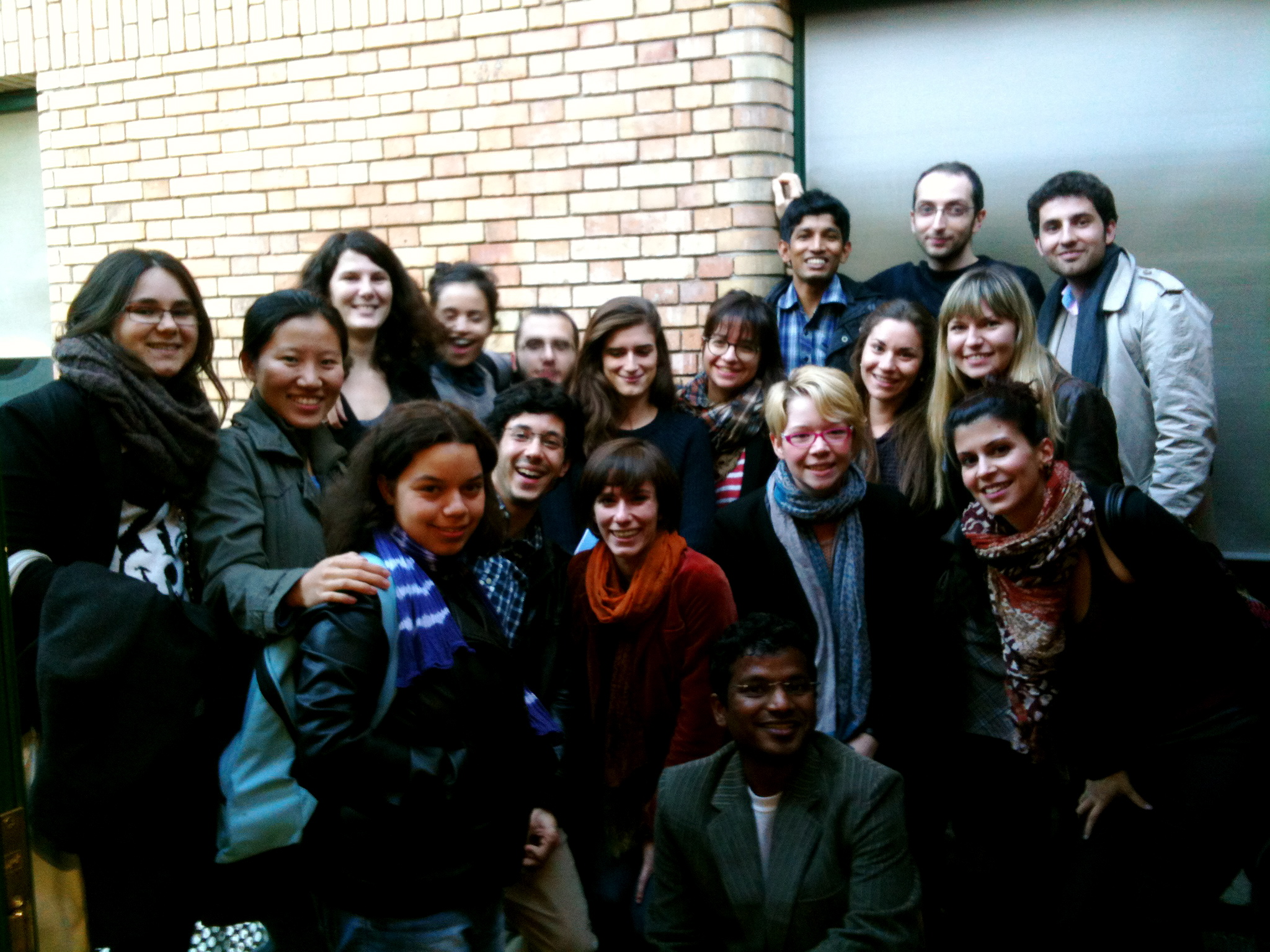
And now on to the January posts.
Mouse development
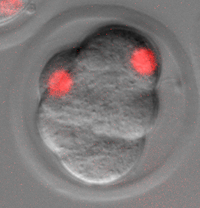 Stephanie Vanderweide travelled from California to Montreal in the middle of the Canadian winter to learn how to microinject 2-cell and 8-cell mouse embryos in Yojiro Yamanaka’s lab, as part of a project to study the molecular mechanisms involved in the first lineage decision of the developing mouse embryo.
Stephanie Vanderweide travelled from California to Montreal in the middle of the Canadian winter to learn how to microinject 2-cell and 8-cell mouse embryos in Yojiro Yamanaka’s lab, as part of a project to study the molecular mechanisms involved in the first lineage decision of the developing mouse embryo.
Heather writes about a technique developed in the Niswander lab, where she’s a student. The lab set up a confocal-based live imaging system to visualize mouse embryo development in real time.
“We have been using this system to study neural tube closure, but there are many other tissues and organs that develop during these time periods (E8.5-E10.5) that are amenable to imaging including the heart, face, limbs and neural crest. By using tissue-specific Cre- recombinase reporter strains, the behavior of individual cell types can now be observed in real time in the early mammalian embryo.”
Woods Hole Embryology course
The application period for the 2013 Woods Hole Embryology Course has been extended to February 8. If you’re accepted to the course, we may see your images on the Node in the future: this is the course that produces the gorgeous images that Node readers have selected for Development covers. Speaking of which, the first round of images from the 2012 course are now up!

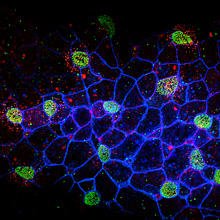
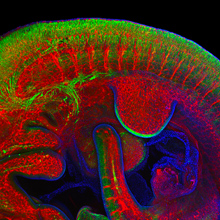
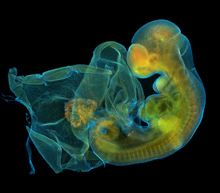
Publishing discussions
Finally, we’ve covered two very different discussions related to scientific publishing: peer review and the secrets behind methods sections.
-Katherine Brown wrote a post responding to an earlier discussion, about the future of peer review – both in general and in the specific case of Development.
-Eva followed the #overlyhonestmethods hashtag on Twitter, where within a few days hundreds of scientists shared the true stories behind their methods sections.
Also on the Node
-Lots of new job ads
–Hope for Huntington’s
–Top posts of 2012
Posted by MichelVervoort, on 31 January 2013
Closing Date: 15 March 2021
A two-year post-doctoral positionis available in the group of Guillaume Balavoine and Michel Vervoort (http://www.ijm.fr/en/ijm/research/research-groups/metazoaires/) at the Institut Jacques Monod (IJM) in Paris (France). The IJM is a leading French biological research institute, comprising about 25 interactive research groups and high-quality technological facilities, including a cutting-edge imaging platform.
The primary research focus of the group is to reconstruct the early stages of animal evolution, by comparing the genetic networks that regulate the developmental patterning of key aspects of the body plan across metazoans. The main model studied by the group is the annelid worm Platynereis dumerilii, an emerging model species. Platynereis is a member of the Spiralian/Lophotrochozoan branch of the bilaterian tree and is hypothesized to be as close to a “bilaterian living fossil” as a bilaterian can be, both in terms of genome organization and body plan.
The post-doc project aims at understanding and modelling cell movements and cell shape changes that direct CNS and segment morphogenesis in Platynereis, as well as determining the roles of the Planar Cell Polarity (PCP) and Rho/ROCK/MyoII pathways in these behaviours. The project will be centered on the use of live imaging, molecular and modelling tools.
Candidates should have a strong background in developmental and/or evolutionary biology. Expertise in live imaging would also be welcome. Candidates must hold a Ph.D. degree in developmental or evolutionary biology and have at least one first author publication in a peer-reviewed journal.
Potential candidates should send their application by mail to Guillaume Balavoine (balavoine.guillaume[at]ijm.univ-paris-diderot.fr) and Michel Vervoort (vervoort.michel[at]ijm.univ-paris-diderot.fr) with a statement of interest, a Curriculum Vitae and contact informations for two referees.
The position will remain open until filled; however applications received by March 15th 2013 will be given priority. The starting date is flexible (in 2013), with an early date preferred.
Posted by the Node, on 30 January 2013
Each year, students of the Woods Hole Embryology course produce some amazing images. Last year, readers of the Node selected four images from the 2011 course to appear on the cover of Development.
Now it’s time to do the same with the images from the 2012 course. Here’s the first batch of four images. Please vote in the poll below the images for the one you would like to see on the cover of Development. (Click any of the images to see a bigger version.) Poll closes on February 19, noon GMT.
 1. Chick ectopic limb. An FGF-4-soaked bead was implanted at stage 14. The embryo was fixed four days later, and stained with alcian blue to reveal the developing cartilage of the skeleton. An ectopic limb can be seen developing next to the normal forelimb, and the bead is still present in the body wall. This image was taken by Elsie Place (MRC National Institute of Medical Research).
1. Chick ectopic limb. An FGF-4-soaked bead was implanted at stage 14. The embryo was fixed four days later, and stained with alcian blue to reveal the developing cartilage of the skeleton. An ectopic limb can be seen developing next to the normal forelimb, and the bead is still present in the body wall. This image was taken by Elsie Place (MRC National Institute of Medical Research).
 2. Two day old Xenopus embryo epidermis, highlighting multiciliated cells. The embryo had been injected with mRNAs encoding membrane blue fluorescent protein, Centrin GFP, and Clamp RFP at the 4-cell stage and imaged as a live mount by confocal microscopy. This image was taken by Andrew Mathewson (Fred Hutchinson Cancer Research Center).
2. Two day old Xenopus embryo epidermis, highlighting multiciliated cells. The embryo had been injected with mRNAs encoding membrane blue fluorescent protein, Centrin GFP, and Clamp RFP at the 4-cell stage and imaged as a live mount by confocal microscopy. This image was taken by Andrew Mathewson (Fred Hutchinson Cancer Research Center).
 3. Confocal image (extended focus Z stack) of an E10.5 day mouse embryo (lateral view; thorax) immunostained with antibodies against PECAM (endothelial factor present in the vasculature; red), beta-III-tubulin (neurons; green) and DAPI (cell nuclei; blue). This image was taken by Joyce Pieretti (University of Chicago), Manuela Truebano (Plymouth University), Saori Tani (Kobe University) and Daniela Di Bella (Fundacion Instituto Leloir)
3. Confocal image (extended focus Z stack) of an E10.5 day mouse embryo (lateral view; thorax) immunostained with antibodies against PECAM (endothelial factor present in the vasculature; red), beta-III-tubulin (neurons; green) and DAPI (cell nuclei; blue). This image was taken by Joyce Pieretti (University of Chicago), Manuela Truebano (Plymouth University), Saori Tani (Kobe University) and Daniela Di Bella (Fundacion Instituto Leloir)
 4. Mouse embryo, day E9.5. Widefield fluorescence image showing immunostaining with anti-Tuj1 (orange) and anti-glucagon (green), counterstained with DAPI (cyan). This image was taken by Eduardo Zattara (University of Maryland, College Park).
4. Mouse embryo, day E9.5. Widefield fluorescence image showing immunostaining with anti-Tuj1 (orange) and anti-glucagon (green), counterstained with DAPI (cyan). This image was taken by Eduardo Zattara (University of Maryland, College Park).